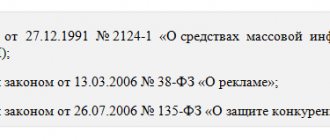The main ways to protect the rights of landowners, land users and land owners
The legislation provides several ways to protect violated rights. The most complete list of such methods is contained in Art. 12 of the Civil Code of the Russian Federation.
When restoring the situation that existed before the violation of the right to a land plot and suppressing actions that violate the right to a land plot or create a threat of its violation, in addition to the Civil Code of the Russian Federation, the provisions of Art. 60 Land Code of the Russian Federation.
The violated right to a land plot is subject to restoration in the following cases:
1) the court invalidates an act of an executive body of state power or an act of a local government body that entailed a violation of the right to a land plot; 2) unauthorized occupation of a land plot; 3) in other cases provided for by federal laws.
Modern land legislation does not have a clear classification of methods for protecting violated or disputed rights. For example, actions that violate the land rights of citizens and legal entities or create a threat of their violation can be suppressed by:
1) invalidation in court of acts of executive bodies of state power or acts of local government bodies that do not comply with the legislation; 2) suspension of the execution of acts of executive bodies of state power or acts of local government bodies that do not comply with the legislation; 3) suspension of industrial, civil, residential and other construction, development of mineral and peat deposits, operation of facilities, carrying out agrochemical, forest reclamation, geological exploration, prospecting, geodetic and other work in the manner established by the Government of the Russian Federation; 4) restoration of the situation that existed before the violation of the right, and suppression of actions that violate the right or create a threat of its violation.
The method of protection known as recognition of rights is of great importance. In particular, recognition of a citizen’s right to a property share and land share during the reorganization of collective and state farms. Such claims occur quite often in judicial practice. In this case, the court usually recognizes such a right for persons who worked in a reorganized agricultural enterprise and retired.
In accordance with Art. 59 3 Code of the Russian Federation, recognition of the right to a land plot is carried out in court.
A court decision establishing the right to land is a legal basis, in the presence of which the state registration authorities of rights to real estate and transactions with it are obliged to carry out state registration of rights to land or transactions with land in the manner established by the Federal Law "On State Registration of Rights to Real Estate" property and transactions with it."
The features of various methods of protection depend on the characteristics of the subjects who seek protection of their rights. For agricultural organizations and entrepreneurs, for example, such methods as recognition of rights, restoration of the situation that existed before the violation, collection of penalties and compensation for losses are typical.
How to protect your rights?
Methods of protecting the rights of the owner of a land plot can be divided into two large groups:
- extrajudicial.
The owner independently sends a written claim to the other party to the dispute demanding that the violation be stopped. A certain deadline is set for satisfying the requirements. In addition, the owner can file a complaint with government authorities so that they bring the perpetrator to justice;
- judicial
A citizen files a claim in court.
Note! A claim to protect the rights of the owner of a land plot can only be filed in the court located at the location of the plot of land (Article 30 of the Civil Procedure Code of the Russian Federation (hereinafter referred to as the Code of Civil Procedure of the Russian Federation).
What is the ratio of “damages”, “losses” and “harm”?
Compensation for damages is in accordance with Art. 12 of the Civil Code of the Russian Federation is one of the ways to protect the rights of citizens and organizations.
1. Losses caused by violation of the rights of owners of land plots, land users, landowners and tenants of land plots are subject to compensation in full, including lost profits, in the manner prescribed by civil legislation.
2. Based on a court decision, a person guilty of violating the rights of land owners, land users, landowners and tenants of land plots may be forced to fulfill the obligation in kind (restoration of soil fertility, restoration of land plots within the previous boundaries, construction of demolished buildings, structures, structures or demolition of illegally erected buildings, structures, structures, restoration of boundary and information signs, elimination of other land offenses and fulfillment of arising obligations).
Losses represent, first of all, economic (material) damage. Losses include actual damage (the value of lost property) and costs that the person whose right was violated has incurred or will have to incur to restore his right (clause 2 of Article 15 of the Civil Code of the Russian Federation). Losses also include lost income that could have been received under normal conditions (lost profits).
Losses can be caused as a result of both lawful (for example, as a result of the seizure of a land plot used for growing crops for the construction of a federal road) and unlawful actions (for example, destruction of property by arson).
Most often, losses are caused as a result of the seizure of a used land plot. Such withdrawal is possible only in cases provided for by law. In particular, in Art. 235 of the Civil Code of the Russian Federation names the grounds for termination of ownership: seizure of a land plot for state or municipal needs and for other reasons, alienation of real estate in connection with this and requisition.
On January 28, 1993, the Government of the Russian Federation adopted Resolution No. 77 “On approval of the Regulations on the procedure for compensation of losses to land owners, landowners, land users, tenants and losses of agricultural production” (as amended on December 27, 1994, November 27, 1995, July 1, 1996)
This Resolution approved the Regulations on the procedure for compensation of losses to land owners, landowners, land users, tenants and losses of agricultural production, as well as standards for the cost of developing new lands to replace seized agricultural land for non-agricultural needs.
In accordance with the norms of the said Regulations, in addition to the concept of losses (mentioned above), the concept of “loss” is established. Losses mean a reduction (irretrievable loss) of the areas of used agricultural land or a deterioration in their quality (decrease in soil fertility) under the influence of the activities of enterprises, institutions and organizations. Losses are compensated in order to maintain the level of agricultural production by restoring agricultural land areas and their quality.
When providing agricultural land for non-agricultural needs for temporary use or lease, the amount of losses in agricultural production is calculated as a percentage of the cost standards for developing new land. For each year of temporary use up to 3 years or rental up to 10 years inclusive, 5% of the established standard is charged. For subsequent rental years: from 11 to 20 years - 2% for each year, from 21 to 50 years - 1% of the standard.
Similar standards are also approved at the level of constituent entities of the Russian Federation. Thus, in Moscow, by order of the Mayor of Moscow dated December 7, 1998 No. 857-RM, the Regulation “On the procedure for the seizure of land plots in Moscow and compensation for losses caused”1 was approved. By order of the Mayor of St. Petersburg dated June 15, 1993 No. 442-r, “Standards for the assessment of fruit and berry plantings to reimburse the cost of these plantings to citizens when allocating their land plots for state or public needs” were approved.
In addition to the term “losses”, when causing damage, the legislation uses the term “harm”.
Typically, harm is said to occur when damage is caused to human life and health (physical and moral harm) and to the natural environment (ecological harm). However, the term "harm" can be used as a general term to refer to damage of any kind. It is in this meaning that it is used in Chapter 59 of the Civil Code of the Russian Federation.
When harm is caused, obligations arise as a result of the harm caused. Such obligations are non-contractual: they usually arise between persons who are not in a contractual relationship. This is another difference between harm and losses that are caused to each other by parties in contractual relations (see the example above).
Harm may result from an action or omission. For example, as a result of environmental pollution (action) or failure to take measures to prevent soil erosion (inaction).
Harm is usually caused by unlawful acts. In addition to the wrongfulness of the act, the grounds for compensation for harm are: a causal connection between the action (inaction) and the resulting result (harm), as well as the guilt of the causer.
When determining the amount of compensation for damages, a general rule is applied: the amount of damage is established at the prices that existed at the time of compensation for damage (Article 393 of the Civil Code of the Russian Federation).
Sometimes it is difficult to determine the amount of harm caused (as a rule, this situation arises when harm is caused to the environment, wildlife, etc.). In these cases, the initial principles for determining the amount of compensation are established in a regulatory manner: either rates are approved, or calculation methods are determined, or other methods are indicated.
Protection of the rights of bona fide land purchasers
As the practice of the legal agency “DF” shows, situations often arise when transactions for the sale of land plots are carried out by unauthorized persons. As a consequence, such transactions are contested by the legal, “real” owners of the land. In this context, the good faith of the purchasers should be understood as the lack of awareness of the buyer about the violation of the rights of third parties. That is, when purchasing a plot of land, the buyer did not and could not know that the transaction was being carried out by a person who did not have the right to sell.
When concluding any transaction, buyers must exercise caution and thoroughly check the circumstances related to the identity of the seller and whether he has rights to the plot; all available land documents; absence of claims to the object of the transaction on the part of third parties, etc.
In addition, a bona fide purchaser must contact the Unified State Register of Real Estate to obtain an extract on the land plot and take all measures to ensure that the seller is honest. Even visiting a land plot before purchasing it and inspecting it on site can play a decisive role in protecting the right!
Otherwise, in the absence of proof of the above circumstances, the court will refuse to protect the bona fide purchaser’s rights.
Thus, the Supreme Court of the Russian Federation did not protect a bona fide purchaser of a land plot, who acquired it from the seller, who is the owner, on the basis of a court ruling, which was subsequently cancelled.
Particular attention should be paid to the price of the land plot that is the subject of the transaction. We often see situations where a “naive” buyer rejoices when he finds “that very plot of land that he has long dreamed of, and at an attractive price!”
Be careful, because if a dispute arises, the court will not be on your side!
If the court finds that the contract price of your land plot was significantly underestimated in relation to its market value, then this fact may be regarded by the court as a circumstance indicating a conspiracy between the seller and the buyer, and, therefore, the possibility of reclaiming the land plot from the buyer . If this did not happen, then the protection of the rights of a bona fide purchaser of the plot will not be ensured.
Unfortunately, situations often arise when, even with sufficient caution, the purchase of land is fraught with unpleasant consequences.
For example, several years after the purchase of land, the real owners are announced. The owners of the land plot are challenging the deal and are trying to get their land back. It is difficult for the acquirer of a land plot to prove good faith and, as a result, to ensure the protection of rights.
The question arises: what to do in such a situation, how to protect yourself?
First of all, we strongly recommend that you seek the help of a qualified lawyer. This category of disputes requires detailed study and vast experience in this area, because there are a huge number of features associated with the category of land, with the subject of law, with land allotment documents, with changes in land legislation, which together are of enormous importance.
It should be noted that there are many factors influencing the “fate” of a case. The owner of a land plot, challenging the transaction under which you acquired the land, will resort to all possible methods of defense.
Please note that your rights will not always be protected, even if you complete all preliminary actions before the transaction.
Judicial practice on this issue today is quite stable, and disputes in which bona fide buyers of the treasured “acres” act on the side of the defendants are resolved in favor of the legal owners of land plots - the plaintiffs.
The plaintiff owners in the courts actively prove the fact that the disputed land plot left the plaintiff’s possession against his will, and therefore the courts satisfy the claims regardless of the fact that a bona fide purchaser is on the defendant’s side.
Taking into account the fact that a bona fide purchaser is initially the less protected party in this category of dispute, the legislator has provided for certain compensation for him.
If the claim of the real owner is satisfied, according to which the land will go to him, and the bona fide owner will suffer innocently, the bona fide owner has every reason to demand compensation for the costs of acquiring the land, losses and lost profits.
By proving conscientious behavior, you can recover not only the cost of the land plot, but also the amounts that were spent on its improvement and construction.
Among other things, remember the statute of limitations! In this category of cases, it is also three years and begins to run from the moment the legal owner discovers his land plot in someone else’s illegal possession (from the same bona fide purchaser).
It is important to understand that this category of disputes requires the intervention of a competent specialist, whose knowledge and experience will help ensure reliable protection of the rights of bona fide purchasers.
In what order are damages caused by the seizure of a land plot compensated?
A land plot may be withdrawn for the placement of state or municipal facilities (Article 49 of the Land Code of the Russian Federation).
In accordance with Art. 64 of the Land Code of the Russian Federation, the seizure of land plots, including through their purchase, for state or municipal needs is carried out after:
1) provision, at the request of persons from whom land plots are confiscated, including purchased, of equivalent land plots;
2) reimbursement of the cost of residential, industrial and other buildings, structures, structures located on the seized land plots;
3) full compensation for losses, including lost profits.
Persons from whom a plot is being confiscated, no later than one year before the upcoming confiscation, including through redemption, must be notified of this by the executive body of state power or the local government body that made the decision to confiscate, including through redemption, land plots. plots.
Confiscation, including through redemption, of land plots before the expiration of a year from the date of receipt of the notification is permitted only with the consent of the owners of land plots, land users, landowners, and tenants of land plots. Also, only with the consent of the owner is it possible to withdraw part of the land plot.
Expenses incurred for the development of land plots with permanent buildings and other activities that significantly increase the value of land, after notification of the upcoming seizure, including through redemption, of land plots are not subject to reimbursement.
In addition, the owners of land plots, when they are withdrawn for state or municipal needs, must be compensated for the market value of the land plot, unless they are given free ownership of an equivalent land plot.
The above-mentioned Regulations, approved by the Decree of the Government of the Russian Federation of January 28, 1993, establish a procedure for compensating losses to land owners, landowners, land users and tenants caused by the seizure or temporary occupation of land plots, restriction of their rights or deterioration in the quality of land, as well as losses of agricultural production caused by withdrawal or restriction of use, deterioration in the quality of agricultural land. These rules apply to lands of all categories, with the exception of lands for which a different compensation procedure has been established.
It should be taken into account that this Regulation does not apply to the forced purchase of land plots from owners in terms of compensation for losses and lost profits and does not establish a procedure for compensation for damage in connection with the loss of the value of agricultural land when provided for Non-agricultural needs (for example, environmental protection, health, recreation) .
If land plots are withdrawn for non-agricultural needs, the amount of damages and losses is established at the stage of preliminary approval of the location of the facility and is clarified at the stage of withdrawal and provision of plots.
The land management project for the formation of non-agricultural land use, prepared during the seizure process, must include the following information:
- on the location of land and construction projects;
- on the area of the land plot, the composition of land provided and included in the sanitary (security) or protective zone and their cadastral valuation;
- on the area, composition and cadastral valuation of lands intended for the placement of objects brought in from allocated lands or from lands of a sanitary (security) or protective zone;
- on the conditions and timing of restoration of disrupted production;
- on the conditions and timing of removal, storage (preservation) and use of disturbed fertile soil layer;
- on the conditions and timing of land reclamation;
- about the amount of damages, including lost profits;
- about the amount of losses;
- on the amount of land tax on the provided lands before withdrawal and the expected amount of land tax after their withdrawal;
- on the conditions and terms of withdrawal, occupation and use of the provided lands.
The Regulations specifically establish that this land management project is subject to mandatory state environmental impact assessment.
If the land plots are not withdrawn, but the rights of the owners are limited, or if the quality of the land deteriorates as a result of outside influence, the land management project establishing the amount of damages and losses must include the following sections:
- area, composition and cadastral valuation of lands that are subject to restrictions on the rights of land users or deterioration in the quality of their lands;
- the impact of restricting the rights of land users or deteriorating the quality of their lands on the productivity of land and the profitability of production;
- measures to reduce or eliminate the further impact of restrictions on the rights of land users or deterioration in the quality of land on the productivity of land and the profitability of production;
- conditions and terms for restoring disrupted production;
- the amount of damages, including lost profits;
- size of losses;
- the amount of land tax levied before and after the rights of land users are limited or the quality of their lands is deteriorated.
In case of temporary seizure of land plots (usually for a period of up to three years), damages and losses are compensated when the land is provided for use and are clarified after the release of these plots.
Ownership of land as an object of protection
Throughout Russian history, land ownership has been not a legal, but a political instrument. The provision of vast agricultural lands and other areas to various social groups and categories of the population has always entailed significant social, economic and legal consequences.
Finished works on a similar topic
- Coursework Protection of land ownership rights 420 rub.
- Abstract Protection of land ownership rights 280 rub.
- Test work Protection of land ownership rights 240 rub.
Receive completed work or advice from a specialist on your educational project Find out the cost
Note 1
The specificity of protecting land ownership rights also lies in the fact that over a long period of Russian history, when using land plots, public and state interests took precedence over private ones.
As is known, Article 8 of the Constitution of the Russian Federation guarantees equality of all forms of property. At the same time, current legislation contains a presumption of state ownership of land if there is no evidence that the plots belong to citizens, legal entities or local governments.
At the same time, the mechanism for the implementation and protection of property rights provided for by the Civil Code of the Russian Federation. We have already completed our thesis
The Civil Code of the Russian Federation, in more detail, is the same for all subjects of land relations. And the procedure for acquiring ownerless real estate into ownership does not depend on who acts as an interested party: a government body, a municipality or a citizen.
Looking for ideas for study work on this subject? Ask a question to the teacher and get an answer in 15 minutes! Ask a Question
Thus, the constitutional principle of equality and diversity of forms of ownership needs further development and specification. Without the development and adoption of relevant federal laws and other regulations, many provisions of the Russian Constitution We have already completed an essay
The Constitution of the Russian Federation in more detail remains, in fact, declarative. Therefore, issues related to the protection of land ownership are of particular relevance.
a mandatory condition for the seizure of land from their owners for state or municipal needs . But the legal mechanism for confiscating land from owners, as well as the procedure for receiving compensation payments, has still not been determined.
Picture 1.
To what extent are interested parties compensated for losses incurred?
In all cases, calculations of damages and losses made must be agreed upon with the parties concerned. After such approval, an act is drawn up and registered by the local administration. Disputes regarding the amount and procedure for compensation for damages and losses are resolved by a court or arbitration tribunal in accordance with their competence.
Damages caused are subject to compensation in full, including lost profits. The exception is cases of seizure or temporary occupation of land plots for state and public needs and restrictions on the rights of land users, as well as deterioration in the quality of land as a result of outside influence.
Lost profits are calculated for the entire period of time necessary to restore agricultural production. If land plots are purchased or sold in any other way, losses of land owners (including lost profits) are included in the cost (price) of the plot.
Lost profits are part of the losses of land users caused by the seizure or temporary occupation of land plots. Losses in the form of lost profits are caused by the cessation of land users receiving annual income from the confiscated lands in anticipation of the upcoming period necessary to restore disrupted production.
Losses are compensated to land owners, landowners and land users. The obligation to compensate lies with organizations (citizens) in whose favor the land was alienated or whose activities cause restrictions on the rights of land users or deterioration in the quality of land.
The damages subject to compensation include:
- the cost of residential buildings, cultural and community facilities, industrial and other buildings and structures or the costs of moving them to a new location. In these cases, the assessment is made based on the estimated cost of construction of new buildings, facilities and structures equal to the existing ones in terms of usable area, capacity, capacity and level of mechanization (for standard projects);
- the cost of fruit and berry, protective and other perennial plantings, work in progress;
- losses (costs) caused by the inconveniences of land ownership and land use, losses (costs) necessary to restore the deteriorated quality of land;
- losses (costs) associated with restriction of land user rights;
- lost profit.
Compensation for losses can be made either in cash or in kind. In this case, the organization to which the site is allocated, at its own expense, constructs new facilities in another location. Moreover, if the cost of newly constructed objects is higher than those that are lost, the difference is paid at the expense of the person in whose favor the construction is being carried out.
In case of withdrawal or temporary occupation of land plots, as a result of which the operation of irrigation, drainage, anti-erosion and anti-mudflow facilities and structures (systems) is partially or completely disrupted, losses are determined based on the estimated cost of work for the construction or reconstruction of facilities and structures (systems), including the cost design and survey work, according to the norms, rates and prices in force at the time of land acquisition.
The assessment of water sources (wells, ponds, boreholes, etc.) is carried out according to the estimated cost of work for the construction of new flowing sources of equal flow rate and water quality, including the cost of design and survey work.
The assessment of fruit-bearing fruit and berry plantings, as well as protective and other perennial plantings, is made based on the cost of seedlings and the cost of planting and growing them before fruiting or crown closure (in prices at the time of land acquisition). In cases where lands occupied by fruit-bearing fruit and berry plantings are withdrawn, lost profits are compensated for the entire period, including the year of land withdrawal and the year of obtaining a harvest of fruit and berry plantings on new lands, equal to that achieved on the withdrawn lands.
All other objects, including unfinished construction and non-fruit-bearing fruit and berry plantings, are valued based on the volume of work actually performed by the land user and costs in prices at the time of land acquisition.
If, as a result of the seizure of a plot, inconveniences in the use of land arise (for example, the formation of islands when filling reservoirs, disruption of transport connections, separation of the territory by communications, etc.), they are determined by the amount of one-time costs for the construction of dams, bridges, roads, entrances, and other structures , as well as for the purchase of boats, boats, ferries and other vehicles. Lost profits caused by inconveniences are calculated in the amount of ten times the difference in the annual costs of operating vehicles after the seizure of land (with the formation of inconveniences) and before the seizure of land.
As noted above, losses may be caused by the need to restore the deteriorated quality of land. They include the costs of conducting soil, agrochemical and other special surveys and surveys, as well as measures to ensure the restoration of land quality, and are determined by project documentation.









